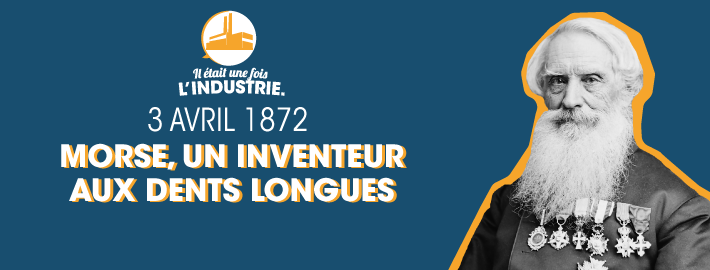GLOBAL
INDUSTRIE
News
Share on

3 April 1872: Morse, a dashing inventor
This week, we tell you about the life and work of a man who marked the history of telecommunications and industry, and who died 150 years ago this week at the age of 80.
AN ACCOMPLISHED ARTIST
Samuel Morse was born on the 27th of April 1791 in Charlestown, near Boston, into a family of intellectuals. His father Jedidiah, in fact, is also considered to be the father of American geography. A brilliant student, the young man entered and graduated from the prestigious Yale University. A painter and sculptor at heart, he then went to London to study art. When he returned to the United States in 1815, his historical paintings and portraits met with some success. In 1826 he founded the National Academy of Design, a fine arts association in New York, of which he was the president for twenty years. From 1829 to 1932 he went back to Europe, living in France and Italy, to complete his artistic culture. It was during the return voyage that he became acquainted with a renowned geologist, Charles Thomas Jackson, who spoke to him of the respective virtues of the electromagnet and of the work of Ampère. Their conversations were the source of the great idea for which his name was to go down in history in general, and in the history of industry in particular.
MORSE CONNECTS THE DOTS
To give credit where credit is due, the telegraph was invented by Claude Chappe. It was this French inventor who created the first model in 1793, as recounted in a previous article in this column. Nor was Samuel Morse the inventor of the electric telegraph, being preceded by several European forerunners, including Ampère. His great - and highly significant - achievement was to have designed a machine which was simultaneously easy to use, sturdy, effective and relatively economical and to have managed to persuade decision-makers to finance this project which was sufficiently spectacular to attract attention and thus ensure its success.
In 1835, three years after his decisive meeting with Jackson, the first model of his electric telegraph was ready. Its inventor was less so, as he was still devoting most of his time to teaching painting and sculpture at New York University. Nevertheless, in 1837, he joined forces with a science professor colleague, Leonard Gale, and a young machinist, Alfred Lewis Vail, who made his parents’ metalwork shop available to produce a prototype of the machine. It was apparently Vail in fact who had the idea of the famous code made up of dots and dashes. Morse, whose ambition needed no decoding, attempted to get America and Europe interested in his invention. He was unsuccessful to begin with, until a Member of Congress more far-sighted than his colleagues, F. O. J. Smith, agreed to team up with him.
Things accelerated after that. The patent for his telegraph was filed in 1840 and in 1842 an underwater line connecting Manhattan Island to Brooklyn and New Jersey was built in association with Samuel Colt, the famous inventor of the revolver. In 1843, Morse obtained 30,000 dollars from Congress to build a second line between Baltimore and Washington, cities 60 kilometers apart. Its opening, on the 24th of May 1844, made a big impression and simultaneously ensured the success of his business. In 1846, his telegraph was developed by private companies. Many competitors then attempted to reap the benefits from it. Morse dashed to the defense of his invention, suing his rivals systematically, and in 1854 obtained validation of his patents from the Supreme Court.
"What hath God wrought" – The first message sent from the Supreme Court in the Capitol to Baltimore Railway Depot on the 24th of May 1844
2022.03.28